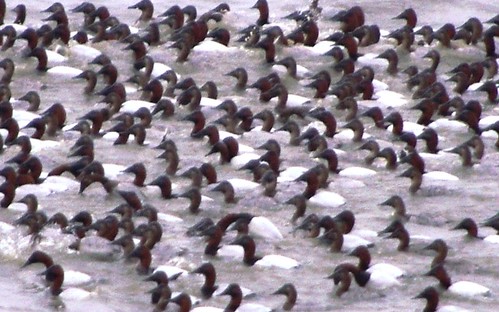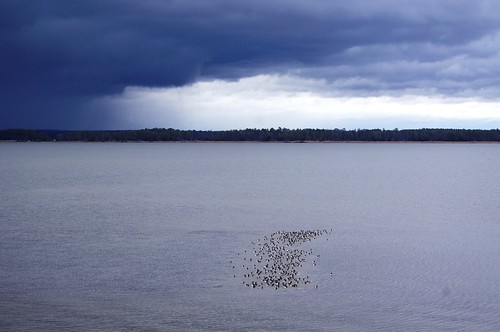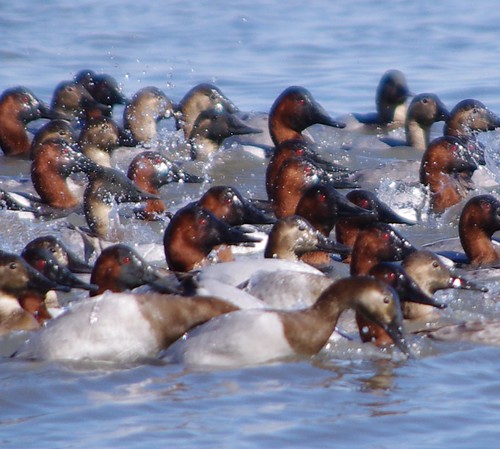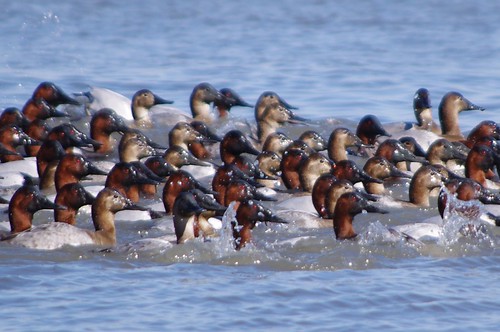Open fires are prohibited throughout the park from midnight to 4 p.m. through April 30 per the 4 p.m. Burning Law. This includes wood and charcoal. Gas is permissible. Campground fires are allowed during the restricted time if a camp host is on duty and signage to that effect is posted in the campground. Failure to observe the 4 p.m. Burning Law can result in a fine. Contact the Park Office for additional information.
Read Our Blogs
A Day in the Life of York River State Park: Canvasback Armada
Jewels of Winter Birding
I am a fan of waterfowl watching. Birding for colorful blue jays, cardinals, and other backyard species has its merits as these birds are available year-round and are often used to introduce kids and newcomers to the outdoors to birding. However, wild ducks and geese are only with us from November to early March.
The male bufflehead drake glistens with shades of green and purple sometimes black looking on its white head. The familiar "quack" of the mallard can be heard in the bog and small beach at Croaker Landing. Ruddy ducks have been known to raft (swim closely) in groups of more than a hundred. But this year, a different bird has taken center stage.
Canvasbacks cruising the York River
Canvasbacks Command the River
The canvasback is about 20 inches long with a 33 inch wingspan. They feed in less than 4 feet of water where they can easily dive for insect larvae and snails in addition to their vegetarian diet. These ducks are no strangers to our shoreline and have been seen in rafts up to 30. Perhaps due to conservation efforts in the US and Canada, their numbers have increased dramatically, up to 100 in a raft. We have seen Canvasback rafts change shape from long lines to single clusters. Watching them swim, dive, and surface in formation is worth taking a winter stroll from our Maritime Overlook gazebo to fossil beach.

York River State Park is a great place for birding and photography
Catching a Glimpse and Image
Canvasback rafts are spotted easily from anywhere on the shoreline. The rafts are usually huge and the birds are much closer to each other than the smaller and more scattered buffleheads. With a good pair of binoculars or spotting scope, the drakes are easily distinguished with their rust-colored heads and hens with being brown. Both sexes have a white/gray body. Photographers with a 300mm lens, 20x zoom or better should be able to capture some good images. By getting closer to them along the fossil or seining beach, you will hear and see them splashing around.

There is no foul weather for water fowl
Count Birds in Our Back Yard
If you wish to help researchers understand canvasbacks and our other feathered friends, Come to York River State Park and participate in the Great Back Yard Bird Count on February 13 thru 15, 2015.
This is a self-guided program where you count the different species and population of birds. Spend as much or little time as you wish and submit your findings online. Perhaps with your help, we will find out if the large rafts of these wonderful waterfowl are a mere fluke, or a sign of things to come.

See them at York River State Park before they fly back north
Directions to York River State Park: From I-64, take the Croaker Exit 231B. Go north on Route 607 (Croaker Rd.) for one mile, then right on Route 606 (Riverview Rd.) about one and a half miles to the park entrance. Take a left turn into the park.
If you have read the article and have a question, please email nancy.heltman@dcr.virginia.gov.
Search for blogs
By Park
Categories
Cabins
Camping
Fishing
History and Culture
Other
Programs and Events
Trails
Volunteers
Water Fun
Archive
2024
2023
2022
2021
2020
2019
2018
2017
2016
2015
2014
2012















